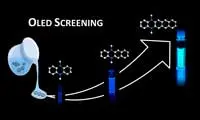 Using a screening process developed by chemists at Goethe University Frankfurt, it is now possible to identify more quickly structures for organic light-emitting diodes (OLEDs) with superior luminescence and charge-transport properties.
Using a screening process developed by chemists at Goethe University Frankfurt, it is now possible to identify more quickly structures for organic light-emitting diodes (OLEDs) with superior luminescence and charge-transport properties.
According to the researchers, organic materials are the most effective way to master the rising demand for display technology. In particular, molecules from the class of materials known as polycyclic aromatic hydrocarbons (PAHs) can be used to produce large and flexible flat screens with high resolution and low energy consumption.
The research team is working on new types of organic luminescent materials which owe their promising properties to the introduction of boron atoms into the PAH scaffold but the syntheses required have been complex and time-consuming.
A recently developed screening process, which makes a variety of boron-doped PAHs quickly and easily accessible, could in future alleviate this situation. The technique makes it possible to evaluate their potential as OLED materials.
“For a long time, it has been pharmaceutical research which has profited from screening processes,” says doctoral researcher Alexandra John. “Yet it makes sense in the dynamic and growing field of organic materials to use similar strategies to achieve results in a cost-efficient and resource-friendly way.”
The method is said to be based on a three-component reaction: Two components remain unchanged in all reactions whilst the third is chosen from a range of cheaply available PAHs. The reactive boron-containing starting material plays an important role in the assembly of the molecular scaffold.
In addition, it is said to give the compounds obtained the desired optoelectronic properties by increasing luminescence and improving the materials’ electrical conductivity.
Author
Peggy Lee
Source: www.newelectronics.co.uk

